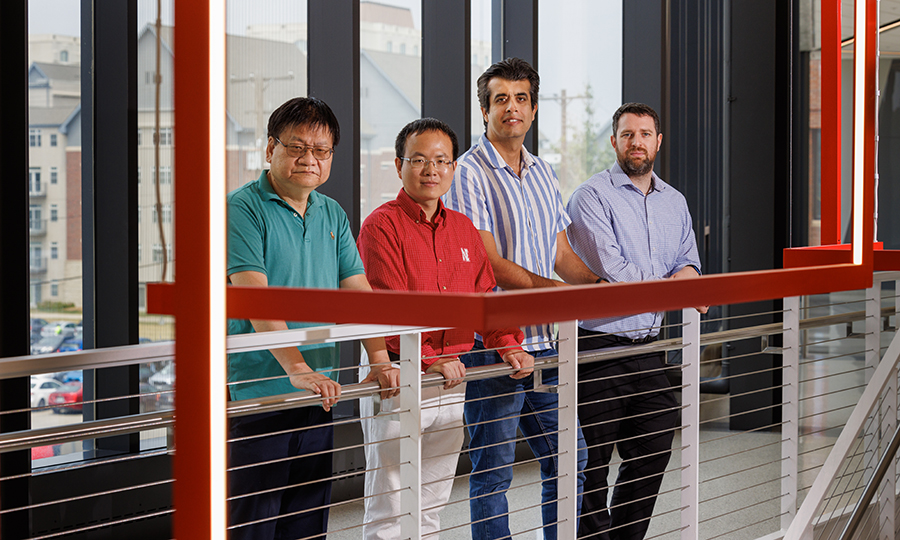Calendar Icon
Jun 29, 2023
Person Bust Icon
By Karl Vogel
![]() RSS
Submit a Story
RSS
Submit a Story

Bai Cui is looking to eliminate defects in 3D-printed ultra-high temperature ceramics that have superior strength and resistance to super-high temperatures.
Piyush Grover is purposefully introducing specific defects into structures to control the propagation of solitary waves and the mechanical energy they carry.
The two mechanical and materials engineering researchers each are among the 28 investigators who have been awarded three-year, $600,000 grants from the Defense Established Program to Stimulate Competitive Research (DEPSCoR).
The Department of Defense (DoD) announced recently $18 million in DEPSCoR awards for Fiscal Year 2022, and the University of Nebraska-Lincoln was one of five institutions with multiple projects selected for funding. Both Cui's and Grover's projects were awarded through the Research Collaboration competition, which features teams led by faculty who have not previously received DoD research funding and collaborations with faculty who are veterans of recent DoD projects.
“I’ve been in this field as a researcher for over 10 years since earning my Ph.D., and this is exciting,” said Cui, Vernon McBroom Associate Professor of Mechanical and Materials Engineering. Cui is collaborating with Yongfeng Lu, Lott Distinguished Professor in electrical and computer engineering, who provides expertise in laser-material interactions. Lu’s research has included developing systems to prevent and repair corrosion on Navy ships.
“He’s got a lot of experience with DoD, and that’s very crucial to success in a project – having somebody who knows what is involved at every step.”
“The rules and regulations keep changing, so it’s good to have somebody who has established contacts and can act as a counselor or mentor,” said Grover, assistant professor of mechanical and materials engineering. Grover is collaborating with Keegan Moore, assistant professor of mechanical and materials engineering and a recipient of an Air Force Office of Scientific Research Young Investigator Research Program grant.

Cui’s team is creating a new process – a blend of ceramic powders that are heated by a laser and fused together – to create products through additive manufacturing or 3D printing.
This product, Cui said, would be valuable for applications that require materials that can survive exposure to temperatures of greater than 3,000 Celsius (roughly 5,400 Fahrenheit). These could include parts for hypersonic vehicles, such as aircraft which can reach speeds greater than Mach 5, and for next-generation nuclear reactors.
“Only a few materials can survive this temperature and still provide sufficient strength, which is why we need to marry different families of carbide and boride ceramics to create composites for this process,” said Cui, whose research project is also supported by Michael Bakas of the Army Research Office.
One of the most important aspects of his project, Cui said, is learning how laser energy is absorbed by ceramic materials that guide us to control the laser’s parameters to create a more precise print.
The coalescing of these powders into a new mass, known as sintering, often leads to cracks in 3D-printed products because rapid heating and then cooling by laser beams makes the ceramics “thermal shock,” Cui said.
“The ultimate goal is to provide sufficient thermal conductivity that is comparable to ceramics made in conventional ways, but are stronger and can avoid general cracking,” Cui said. His research project is supported by Dr. Michael Bakas of the Army Research Office, a directorate of the U.S. Army Combat Capabilities Development Command Army Research Laboratory.

While Cui is looking to eliminate defects, Grover is introducing specific defects into architected mechanical materials to allow for manipulation of solitary waves traveling in those metamaterials and, potentially, the harnessing of the energy that the waves contain.
Solitary waves – or solitons – propagate with little loss of energy and retain their shape and speed after colliding with other such waves.
“The solitons are like a bullet of energy,” Grover said. “They’re very spatially localized. For example, in a spring-mass system idealization of a structure, at any given instant only one of masses will be moving. When these waves travel in a structure, they don’t lose any energy.
By introducing a defect – for example, a weaker spring – into a structure, Grover said, the wave will deflect or stall at the point of collision, creating an opportunity to make the wave move in a way that is beneficial for a specific purpose.
Having the ability to switch defects on and off, Grover said, can cause a wave to be “trapped” in a different region and isolate the primary structure from its impact.
“It’s essentially creating filters that let certain waves pass, but not others,” Grover said. “You can reflect them off something like a ball on a billiards table or make the wave stay at a location by holding on to it for a brief time.
“If you want to, you can then redirect the impact into some useful thing.”
Among those possible uses is repurposing the energy the redirected wave creates before it dissipates or is reflected out of the system.
“It’s like wave tailoring – you get this big packet of energy and you can do different things with it,” Grover said. “Imagine building fully a mechanical circuit where these waves can be used as signals to switch on or off certain functionalities. This capability has uses in soft robotics, space exploration and mechanical computing.”
Submit a Story